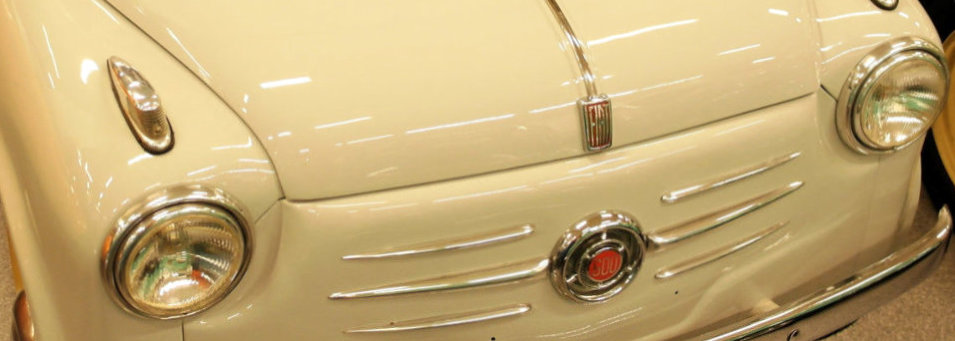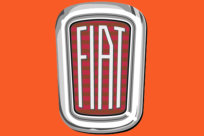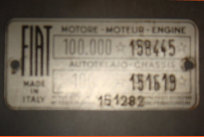




The collection´s car is one from the first series manufactured

Fiat 600 - 55
The Fiat 600 (Italian: Seicento) is a city car produced by
the Italian manufacturer Fiat from 1955 to 1969.
Origin
Measuring only 3.22 m (10 ft 7 in) long, it was the first rear-engined Fiat and cost the equivalent of about € 6,700 or US$ 7300 in today's money (590,000 lire then). The total number produced from 1955 to 1969 at the Mirafiori plant in Turin was 2,695,197. During the 1960s, '70s and '80s, the car became very popular in countries such as Spain (as SEAT 600), where it became the icon, par excellence, of the Spanish miracle, Argentina, where it was nicknamed Fitito (a diminutive of Fiat) and former Yugoslavia where it was nicknamed Fićo.Characteristics
The car had hydraulic drum brakes on all four wheels. Suspension was a unique single double- mounted leafspring - which acts as a stabilizer - between the front wheels coupled to gas- charged shock absorbers, and an independent coil-over-shock absorber setup coupled to semi- trailing arms at the rear. All 600 models had 3-synchro (no synchro on 1st) 4-speed transaxles. Unlike the Volkswagen Beetle or Fiat 500, the Fiat 600 is water-cooled with an ample cabin heater and, while cooling is generally adequate, for high-power modified versions a front- mounted radiator or oil cooler is needed to complement the rear-mounted radiator. All models of the 600 had generators with mechanical external regulators. The top speed ranged from 95 km/h (59 mph) empty with the 633 cc inline-four engine to 110 km/h (68 mph) with the 767 cc version. The car had good ventilation and defrosting systems. A year after its debut, in 1956, a soft-top version was introduced, as well as a six-seater variant — the Fiat 600 Multipla. It was a precursor of current multi-purpose vehicles. Retrospectively the water-cooled Fiat 600 is sometimes over-shadowed by the air-cooled Fiat 500, but the 600 was a remarkably fast seller in its time: the millionth 600 was produced in February 1961, less than six years after the car's launch. At the time when the millionth car was produced, the manufacturer reported it was producing the car at the then remarkable rate of 1,000 a day. As of 2011 there are only 65 left in the UK that are road legal.Derivatives
SEAT 600/800
In Spain, the 600 model was made under the make of SEAT, from 1957 to 1973. Up to 797.319 SEAT 600 were made. The Spanish car maker exported them to a number of countries worldwide. This car motorised Spain after the Spanish Civil War. SEAT produced various derivatives of the original 600 model some of them with improvements and special fittings like the use of "suicide doors": the SEAT 600 D/E/L Especial version, the 'Descapotable' convertible and the 'Formicheta' commercial version etc. The most interesting version produced between 1964 and 1967 by SEAT is though the SEAT 800, the sole four-door derivative of the 600 model which received a longer wheelbase. It was developed in-house by SEAT and produced exclusively by the Spanish car maker without any equivalent model in Fiat's range.Fiat 600/770 Neckar Jagst
The Fiat 600 was also manufactured at Fiat Neckar in Germany between 1956 and 1967. Presented in a first time as Jagst 600, in 1960 with the release of Fiat 600D it became Jagst 770. The model was manufactured until the end of 1967, more than 172,000 copies.Zastava 750/850
In former Yugoslavia the model was very popular, and was produced under the name Zastava 750 (later 850), nicknamed "Fića" in Serbian, "Fićo" in Bosnian and Croatian, "Fičo" in Slovene, and "Фиќо/Фичо" (Fikjo/Ficho) in Macedonian. It was produced by the Zastava factory in Kragujevac, Serbia, from the early 1960s until 1985, during which time it played a major role in motorisation of the country, due to its affordability.South American production
The 600 was built as the Fiat 600 R by Sevel in Argentina from 1960 to 1982, with assembly operations also taking place (beginning somewhat later) in Uruguay by Ayax S.A., and in Chile. At first, Someca S.A. built the 600 with rear-hinged doors and the 633 cc engine (28 hp), mainly from parts shipped in from Italy. As a new plant was constructed in the Ferreyra, a suburb of Córdoba, the local parts content steadily increased. In 1962 the 600D was introduced, with a 32 hp (SAE) 767 cc engine. In August 1964, around the same time that the local firm changed its name to Fiat Concord S.A., the second 600D was introduced, with slight changes to its appearance. The suicide doors continued to be used until the April 1965 appearance of the 600E, which also gained some extra power. Early in 1967 the 600E received a slight facelift with bigger headlights, new rims, and a new "grille" in front. In November 1970 the 600R appeared. The external differences were limited to trim, but the interior saw more thorough changes, with a new steering wheel, inner ceiling, and seat coverings. The hubcaps were replaced with tiny rubber caps. The 767 cc 36 hp (SAE) 600 R (thanks to higher compression than the E) was in turn replaced by the 32 hp (DIN) 843 cc (65.0 x 63.5 mm) 600 S in July 1977, a version featuring new bumpers with rubber overriders and a black plastic faux-grille to replace the previous chrome iteration. Top speed was up from 105 to 110 km/h (68 mph). The 600 was finally replaced by the new 147 in April 1982, after having undergone one last tiny facelift in 1981 (black head and taillight surrounds, a black "shield" up front). In Colombia, it was assembled in the actual motor plant of Mazda in Colombia, Compañía Colombiana Automotriz from 1979 to 1982 with 60% Colombian parts and 40% Serbian parts (from the Zastava 750). Marketed as the Fiat 750Z, colloquially it was called the "topolino".
1955
Engine 633 cc 4 cylinders Power 26 HP Top speed 110 km/h Lenght/width 3,21 m/1,41 m Weight 585 kg The collections 600 has been fully restaured.
Photos mainly by Matti Kreivilä. Historical facts and technical details of the vehicles provided by Wikipedia. Movies YouTube.




- Autobianchi Transformable - 1960
- Autobianchi Familiare - 1962
- Autobianchi Panoramica - 1962
- Autobianchi Cabriolet - 1963
- BMW Isetta 300 - 1956
- BMW Isetta 300 - 1959
- BMW Isetta Standard
- BMW 600 - 1959
- Bond Bug ES 700 - 1973
- Fiat Topolino - 1936
- Fiat Topolino - 1939
- Fiat Topolino - 1951
- Fiat Belvedere - 1952
- Fiat Topolino - 1954
- Fiat 600 - 1955
- Fiat 500 - 1963
- Fiat 500 - 1969
- Fiat Multipla - 1965
- Fuldamobil 4-wheel - 1958
- Fuldamobil King S7 - 1959
- GLAS Isar T700 - 1962
- Goggomobil T400 - 1959
- Goggomobil T250 - 1961
- Goggomobil T250 - 1969
- Goggomobil Coupe
- Heinkel Kabine - 1959
- Honda N600 - 1970
- Jalta Saporoshez - 1967
- Lloyd Alexander TS - 1960
- Messerschmitt KR200 - 1960
- Messerschmitt KR201
- Messerschmitt KR200 - 1963
- Messerschmitt KR200 - 1964
- NSU Prinz I - 1958
- Scootacar Mk3 - 1963
- Steyr-Puch 500 -1961
- Steyr-Puch 650 - 1964
- Trabant P 50 - 1961
- Trojan 603/198 - 1964
- Trojan 3-wheeler - 1964
- Trojan 3-wheeler - 1964
- Vespa 400 - 1959
- Victoria Spatz 250 - 1957
- ZŁndapp Janus - 1959


- About Scooters
- Apollo moped
- Cezeta 175 - 1960
- Heinkel Tourist - 1960
- Lambretta 125 - 1953
- Puch SR 150 - 1958
- Pyrkijš moped
- Suzuki Burgman 400
- Tunturi City - 1980
- Vespa 150 - 1959
- Yamaha Passola 50 - 1980
- ZŁndapp Bella w. sidecar - 1960
- ZŁndapp Bella 204 - 1960
- ZŁndapp Bella 200 Deluxe - 1963
- ZŁndapp Combinette




















